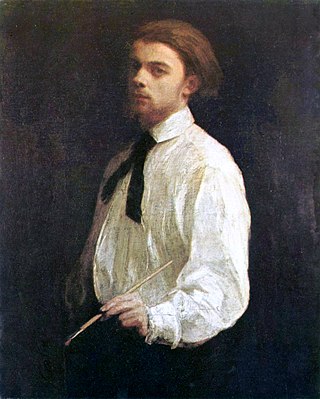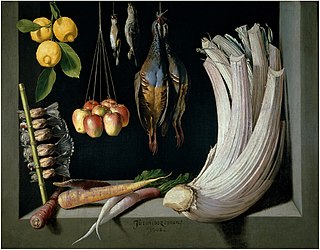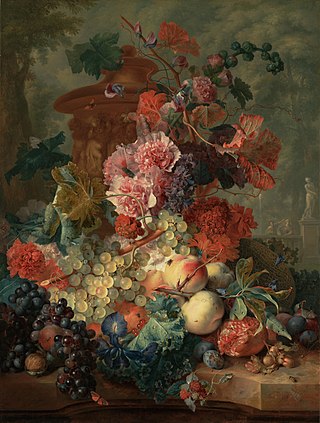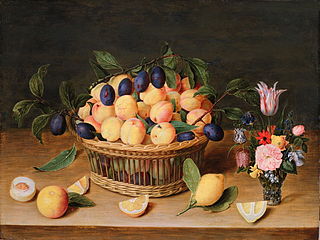
Ambrosius Bosschaert the Elder was a Flemish-born Dutch still life painter and art dealer. He is recognised as one of the earliest painters who created floral still lifes as an independent genre. He founded a dynasty of painters who continued his style of floral and fruit painting and turned Middelburg into the leading centre for flower painting in the Dutch Republic.

Henri Fantin-Latour was a French painter and lithographer best known for his flower paintings and group portraits of Parisian artists and writers.

A still life is a work of art depicting mostly inanimate subject matter, typically commonplace objects which are either natural or human-made.

Jan Davidsz. de Heem or in-full Jan Davidszoon de Heem, also called Johannes de Heem or Johannes van Antwerpen or Jan Davidsz de Hem, was a still life painter who was active in Utrecht and Antwerp. He is a major representative of that genre in both Dutch and Flemish Baroque painting.

Jan van Huysum is the most notable member of the Van Huysum family of artists working in Dutch Golden Age of the 17th and 18th centuries; "by common consent, Jan van Huysum has been held to be the best painter of flowers." Trained in decoration from a young age, he "gradually developed an execution of details of the utmost beauty and finish" creating "wonderful flower pieces whereon drops of water and crawling ants could be seen without a magnifying glass."

George Washington Thomas Lambert was an Australian artist, known principally for portrait painting and as a war artist during the First World War.

Maria van Oosterwijck, also spelled Oosterwyck, (1630–1693) was a Dutch Golden Age painter, specializing in richly detailed flower paintings and other still lifes.

Anne Redpath (1895–1965) was a Scottish artist whose vivid domestic still lifes are among her best-known works.

The Glynn Vivian Art Gallery is the public art gallery of the City and County of Swansea, in Wales, United Kingdom. The gallery is situated in Alexandra Road, near Swansea railway station, opposite the old Swansea Central Library.
Mildred Anne Butler was an Irish artist, who worked in watercolour and oil of landscape, genre and animal subjects. Butler was born and spent most of her life in Kilmurry, Thomastown, County Kilkenny and was associated with the Newlyn School of painters.

Anne Vallayer-Coster was a major 18th-century French painter best known for still lifes. She achieved fame and recognition very early in her career, being admitted to the Académie Royale de Peinture et de Sculpture in 1770, at the age of twenty-six.

Still Life: Vase with Pink Roses was painted in 1890 by Vincent van Gogh in Saint-Rémy. At the time the work was painted Van Gogh was readying himself to leave the Saint-Rémy asylum for the quiet town of Auvers-sur-Oise outside of Paris. This and the similarly-dated Pink Roses reflect the optimism Van Gogh felt at that time about his future, both in his choice of flowers as a subject and the colors used. The painting is owned by the National Gallery of Art of Washington, D.C.

Still life paintings by Vincent van Gogh (Paris) is the subject of many drawings, sketches and paintings by Vincent van Gogh in 1886 and 1887 after he moved to Montmartre in Paris from the Netherlands. While in Paris, Van Gogh transformed the subjects, color and techniques that he used in creating still life paintings.

Jacob van Hulsdonck or Jan van Hulsdonck, was a Flemish painter who played a role in the early development of the genre of still lifes of fruit, banquets and flowers.

Imperial Fritillaries in a Copper Vase is an oil painting on canvas created by the post-impressionist painter Vincent van Gogh in Paris, 1887. The painting is now part of the collection of the Musée d'Orsay in Paris, France. This work was made at a time of the life of Van Gogh when he first encountered influences from Impressionists and became aware of light and color, implementing it in his paintings. This painting presages some of his most famous subsequent works, and stands out from other still lifes because of the implementation of mixed techniques and complementary colors.

The Squatter's Daughter is a 1924 painting by Australian artist George Washington Lambert. It is part of the collection of the National Gallery of Australia in Canberra.

Chesham Street is a 1910 oil-on-canvas painting by Australian artist George Washington Lambert. The work depicts a doctor performing an auscultation on a man with his shirt lifted and torso exposed. The work was painted at the Rossetti Studios on Flood Street in London. The painting is one of a set of "puzzle pictures" painted by Lambert between 1910 and 1914. These paintings are said to "appear to have a meaning and yet are not strictly narrative; they invite the viewer to provide their own interpretation.".
The man sits boldly in front of the viewer, holding up his shirt and revealing his entire torso. His head is held high, his lips are closed and he looks down at the viewer, seeming somewhat superior. His pale flesh, with the play of light on it, gleams against the dark surroundings.

The convex mirror is a c 1916 oil with pencil on wood panel painting by Australian artist George Washington Lambert.

Self-portrait with gladioli is a 1922 oil-on-canvas painting by Australian artist George Washington Lambert. The painting, a self-portrait, depicts Lambert in a brown velvet gown, wearing a purple scarf with a vase holding a gladiolus in front of him.

Roses in a Glass Vase is an oil-on-canvas painting by French artist Henri Fantin-Latour, executed in 1879. The painting has the dimensions of 68 by 53 cm, and is signed and dated at the top left. It is held at the Manchester Art Gallery.



















